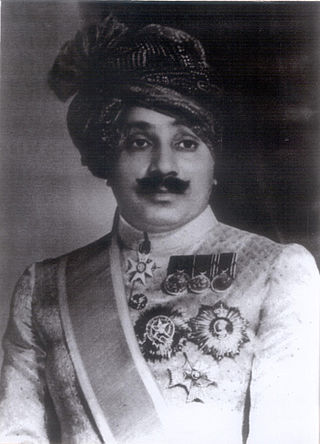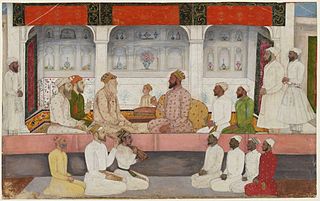Related Research Articles

The Maratha Empire, also referred to as the Maratha Confederacy, was an early modern Indian empire and later a confederation that controlled large portions of the Indian subcontinent in the 18th century. Maratha rule formally began in 1674 with the coronation of Shivaji of the Bhonsle dynasty as the Chhatrapati. Although Shivaji came from the Maratha caste, the Maratha empire also included warriors, administrators, and other nobles from the Maratha and several other castes from what is known today as Maharashtra. The Maratha Kingdom was expanded into a full-fledged Empire in the 18th Century under the leadership of Peshwa Bajirao I.

Peshwa was second highest office in the Maratha Confederacy, next in rank and prestige only to that of the Chhatrapati. Initially serving as the appointed prime minister in the Maratha empire, the office became hereditary after the death of Shahu in 1749. During the reign of Shahu, the office of Peshwa grew in power and the Peshwas came to be the de facto rulers of the Maratha empire. However following the defeat of the Marathas in 1761, the office of the Peshwa became titular as well and from that point onwards served as the ceremonial head of the Confederacy underneath the Chhatrapati.

Lieutenant-Colonel James Tod was an officer of the British East India Company and an Oriental scholar. He combined his official role and his amateur interests to create a series of works about the history and geography of India, and in particular the area then known as Rajputana that corresponds to the present day state of Rajasthan, and which Tod referred to as Rajast'han.

Jhalawar ( ) is a city, municipal council and headquarter in Jhalawar district of the Indian state of Rajasthan. It is located in the southeastern part of the state. It was the capital of the former princely state of Jhalawar, and is the administrative Jhalawar district. Its district headquarters is Jhalawar. This district is the 22nd largest district of Rajasthan. This district is known by the nicknames of Cherrapunji of Rajasthan, Nagpur of Rajasthan, Brijnagar of Rajasthan etc. Cherrapunji of rajasthan because the highest rainfall in the whole of Rajasthan occurs in manoharthana town in this district. Gagron fort at the confluence of Kalisindh and Ahu river at some distance from Jhalawar It is situated which is one of the Jaldurg of Rajasthan and it is such a fort which is a standing fort without foundation. This fort was included in the UNESCO World Heritage List in 2013.

Udai Singh II was the Maharana of Mewar and the founder of the city of Udaipur in the present-day Rajasthan state of India. He was the 12th ruler of the Kingdom of Mewar. He was the fourth son of Rana Sanga and Rani Karnavati, a princess of Bundi.
Nagavarma II was a Kannada language scholar and grammarian in the court of the Western Chalukya Empire that ruled from Basavakalyan, in modern Karnataka state, India. He was the earliest among the three most notable and authoritative grammarians of Old-Kannada language. Nagavarma II's reputation stems from his notable contributions to various genres of Kannada literature including prosody, rhetoric, poetics, grammar and vocabulary. According to the scholar R. Narasimhacharya, Nagavarma II is unique in all of ancient Kannada literature, in this aspect. His writings are available and are considered standard authorities for the study of Kannada language and its growth.

The history of human settlement in the western Indian state of Rajasthan dates back to about 100,000 years ago. Around 5000 to 2000 BCE many regions of Rajasthan belonged as the site of the Indus Valley Civilization. Kalibangan is the main Indus site of Rajasthan, here fire altars have been discovered, similar to those found at Lothal.

The Kingdom of Mewar, sometimes known as Udaipur State, was an independent kingdom in Rajputana region of India, ruled by the Sisodia dynasty. It was established around the 6th century by the minor rulers of the Nagada-Ahar region of Udaipur and later, in the 10th century, it transformed into an independent state under Rawal Bharttripatta II.

Maharajadhiraj Shri Maharaja Mahim Mahendra Maharao Raja Sir Umaid Singh II was the Hada Chauhan ruler of the Princely State of Kotah from the year 1889 to 1940.

Lieutenant-General HH Shri Raj Rajeshwar Saramad-e-Raja-e-Hindustan Maharajadhiraja Maharaja Sir Umaid Singh Bahadur, Assoc KStJ, also spelled Umed Singh, was the Maharaja of Jodhpur State of the historic Rathore dynasty of Marwar from the year 1918 to 1947 until his death.

Jhalawar State was a Princely State in India during the British Raj. It was located in the south eastern historic Hadoti region of Rajputana .The main town in the state was Jhalawar.

Bundi State was founded by Hada Rao Devda currently located in modern-day Rajasthan. It was ruled by Hada Chauhans Rajputs.

Sailana State was an 11 gun salute princely state in India, part of the Malwa Agency of Central India during the British Raj. The state enjoyed an estimated revenue of Rs.5,00,000.
Maroth is a village located in Nawa, Nagaur district, in the state of Rajasthan, India. The area surrounding the village is named Gaurati, which means "The Land of Gaurs". This area was a principality granted by Maharaja Vigharaj Chauhan to Maharaja Bawan Gaur in 1260 AD. In 1659 AD, it was granted by Aurangzeb to Maharaja Raghunath Singh for his service in battle. During this time period the Gaur Rajputs of this area paid more than 6.65% of the Jama (tax) of the principality according to Ain-A-Akbari.

Kota State, also known as Kotah State, was a state in India, centered on the city of Kota, now located in Rajasthan State of the India.

Raghogarh State, also known as Raghugarh and as Khichiwara, was a princely state of the Gwalior Residency, under the Central India Agency of the British Raj. It was a Thikana state of about 109 km2 with a population of 19,446 inhabitants in 1901. The Parbati River marked the western border of the state. The capital was at Raghogarh in present-day Guna district of Madhya Pradesh.
Jagmal Singh was a sixteenth century Indian prince and court figure. He was the son of Maharana Udai Singh II and Rani Dheerbai Bhatiyani.

The Battle of Balapur marked a civil conflict among Mughal leaders, triggered by the uprising of the Sayyid Brothers. This uprising led to a decline in the status of other Mughal leaders.

The Jhala also called Makwana or Jhala-Makwana is a chandravanshi rajput clan, mentioned among the 36 royal races in the Kumara-prabandha list that ruled over Jhalavad region of Gujarat and parts of Rajasthan. HarpalDev Makwana was the founder of Jhala clan.
References
- ↑ Shastri 1971, p. 1.
- ↑ Tod 1994, p. 179.
- ↑ Shastri 1951, p. 322.
- ↑ Shastri 1951, p. 324.